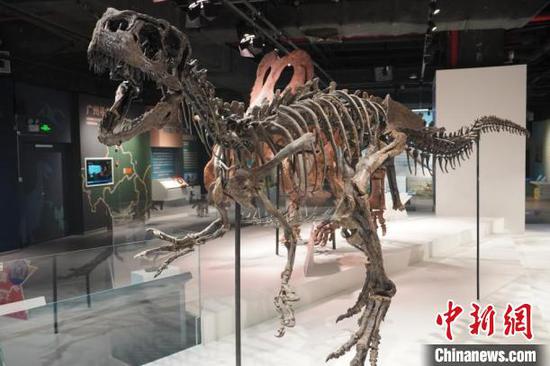New study by Chinese researchers reveals hunting tactics and survival challenges of Allosaurus

An Allosaurus folssil is displayed at a museum in Guangzhou, south China's Guangdong Province. (Photo/China News Service)
A new study by Chinese researchers focusing on Allosaurus, a top predator of the Jurassic era, has offered fresh insights into its forearm motions, its hunting strategies and survival challenges of this formidable dinosaur, a member of the research team said on Thursday.
Jointly conducted by the team from China University of Geosciences and Guangzhou Grandview Museum of Natural Science in South China’s Guangdong Province, the in-depth analysis provided new paleopathological evidence to the forelimb motion range and capacity for shoulder injury recovery of Allosaurus, one of the most common theropod dinosaurs found in the Late Jurassic, according to Liang Qingqing, a member of the research team.
“The biomechanical study of Allosaurus has embraced advanced technologies and innovative methods to better understand this dinosaur's physical capabilities while ensuring the preservation of its fossil specimens,” said Liang.
“One notable technique involves laser scanning of the Allosaurus’ 3D fossil model. This non-invasive method creates highly detailed digital models of the skeleton, allowing researchers to analyze the range of motion, structural mechanics, and functional adaptations of the dinosaur without risking damage to the original, invaluable fossil,” she noted.
The research has led to the recent publication of the latest findings, titled “Forearm range of motion in Allosaurus fragilis” in the international journal Historical Biology.
The joint research is based on a well-preserved Allosaurus specimen in the museum in Guangzhou, which is also the only one publicly displayed in China. This specimen is notable for its exceptional completeness, particularly the skull and abdominal ribs, which are preserved in a condition rarely seen in similar fossils.
Allosaurus lived during the Late Jurassic period, approximately 155 to 145 million years ago. Renowned for its robust build and agile movements, this predator earned the title of "Jurassic Overlord." Its physical capabilities, combined with its dominance in the ecosystem, solidify its reputation as one of the top predators of its time.
The study revealed the impressive flexibility of Allosaurus' forelimbs, with the shoulder and elbow joints capable of extending beyond 70 degrees, and the finger joints able to flex up to 90 degrees. These attributes highlight the forelimbs' crucial role in hunting. The limited range of motion in the shoulder joint suggests that the forelimbs were mainly used for capturing prey rather than further forward-reaching actions. This means that the mouth was likely the first point of contact with prey, while the palms of the forelimbs were employed to grasp the prey's chest or neck region or to hook onto objects, according to the museum.
In addition, the research uncovered the remarkable recovery ability of Allosaurus, particularly after an injury to its right shoulder. Although the dinosaur likely faced extinction due to changes in hunting strategies and subsequent food scarcity, the injury to its shoulder had healed by the time of its death. This showcases not only the resilience of Allosaurus but also the complex interplay between its physical capabilities and survival challenges, Liang said.
These findings contributed valuable insights into the behavior, ecology, and evolutionary adaptations of this iconic Jurassic predator, she added.
